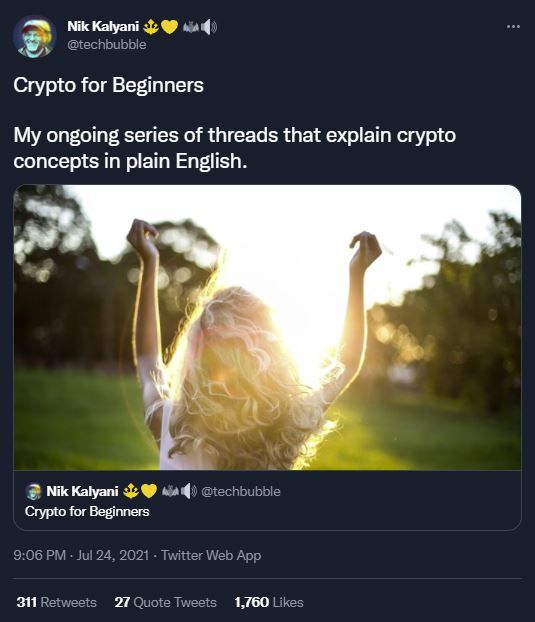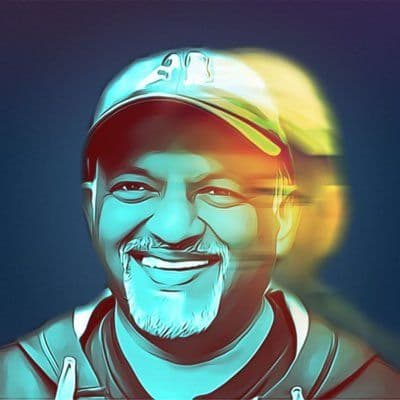Collectors are, without a doubt, the driving force behind the NFT boom in 2021. Some of them focus on PFPs, some on 1/1s, and some collect both an everything in between. One such collector is Nik Kalyani, who also happens to be a founder of each of Decentology and Try Crypto, as well as an active voice in the NFT community.
Hi Nik! Before we dive into your recent ventures, we’d love to hear what you were doing five years ago, before NFTs were really a thing?
I am an entrepreneur at heart and one way to describe my life’s journey is through the startups I was working on at the time. I’ve had four prior startups—two exits and two fails. Five years ago, an Open Source CMS startup (DNN) I co-founded was acquired and I was looking for my next venture. I co-founded WhenHub with Scott Adams (creator of “Dilbert”) and, after a few pivots, we ended up creating “Interface,” a mobile app to connect experts with advice-seekers on a video call with per second billing handled by a smart contract. It was too early in crypto and we never got enough mainstream traction. At the time, I also helped create and instruct Udacity’s Blockchain Nanodegree to teach developers Solidity smart contract programming. Also, I created and launched Walkstarter, a fundraising platform that has raised $4 million for U.S. public schools.
That’s quite a track record! And now you’re the founder of Decentology and Try Crypto. Could you explain to us what both are about, and how they are related?
The genesis of Decentology was my awareness of the intense friction developers encounter in building decentralized applications (“dapps”) from my prior experience. Our mission is to make dapp development super easy for web developers and we hope to onboard at least 10 million of them to the blockchain. We’re building the Hyperverse, an open, decentralized marketplace for “smart modules” which are like Lego block smart contracts that devs can wire up to easily build apps.
I founded TryCrypto to concurrently address three problems in crypto—UX, gender equity and economic equity. The company is run entirely by women focused on building products that make crypto more accessible to mainstream users and making global economic equity a reality.
The common vector for both is to accelerate the transition of our world to decentralization.

What role do NFTs play in crypto in your opinion?
We are at the point where there has been enough experimentation within the crypto petri dish. It is time for crypto to crossover to mainstream use-cases at scale. I believe NFTs have that potential. NFTs are the first crypto applications that are easy for the public to understand (unlike DeFi). NFTs like NBA Top Shot and Axie Infinity have demonstrated this potential and we need to keep building and making the UX better so the general public can start understanding and using crypto.

Why did you decide to start collecting NFTs?
I don’t think it was a conscious decision as I am a tinkerer and constantly trying out new things. My NFT journey began with CryptoKitties and I immediately saw its potential. Playing with the Solidity smart contract code in the early days of NFTs had me hooked and I’ve never looked back. When I got into NBA Top Shot, I finally saw a tangible path to mainstream crypto adoption and that led me to seek out and collect all kinds of NFTs.
You have a stunning collection of NFTs that includes both 1/1 artists as well as bigger projects (BAYC, CryptoKitties, FameLadySquad, amongst others). How do you generally find new projects or artists?
Usually, it’s just word of mouth. My teammates at Decentology and TryCrypto will share info about some new project or I’ll see it on Twitter. It’s probably also because there’s barely an early access signup form I haven’t filled. If the project is authentic, I like to give product feedback.
Discovering new artists is much harder. I ignore all DMs and unsolicited links because I have found those to be the least desirable. Instead, I’ll periodically tweet a topic or a theme and have artists reply with links on those threads where I usually find some gems.
So then what motivators play a role in the decision to collect/invest in a specific NFT for you?
I’ll start by saying that I don’t consider myself a collector—rather, a supporter. I believe that art is very important in life and, with NFTs, we finally have an opportunity to make art open and accessible to everyone, not just the wealthy. I want to encourage new artists and hence I focus on being the first buyer/collector for artists, especially women. Honestly, I don’t have any other motivations—as long as I can give new and young artists the support and confidence they need to stay in this ecosystem and keep it vibrant, I will have achieved my mission. For experienced artists, I want to be a resource to help them navigate crypto technology and also learn business fundamentals like marketing, pricing and strategy.
What has been your biggest collecting ‘mistake’ so far and what did you learn from it?
I think mistakes are important for learning and growth, so technically they aren’t a bad thing for me. That said, I wish I had put more effort into connecting with and learning about the lives, inspirations and motivations of the artists whose works I have collected. I realized that late and started doing YouTube interviews with artists under the NftyDreams label.
What would you recommend artists to do to get a first collector?
I believe this question is phrased incorrectly. It presupposes that the artist is the one that should be looking for a collector—it should be the other way around. If that is not the case (or doesn’t fast become the case), then NFT art is doomed because there is too much supply chasing very little demand.
I think what we see happening right now is a classic case of “foot-gunning.” So many artists shilling their art to a dwindling number of collectors. Instead, they should be focused on making their art more accessible and approachable to a growing audience of mainstream art aficionados. There are three steps to doing this:
- A. Organize. Leaders in the ecosystem need to come together and organize. This is what I have tried to catalyze with NftyDreams, but unfortunately, no leaders have stepped up. It only takes one or two people who are artists and leaders to make this happen.
- B. Curate. Art, while subjective, also has a quality component. There are artists who are in it just to make a quick buck. The art community needs to organize and create curated channels for discovery. Relying on the marketplaces is not a smart solution. Creating curated online galleries, newsletters, live events is the way to go. Artists are not marketers… Team up with marketers and create opportunities for the public to discover high-quality NFT art.
- C. Innovate. The age of static collectable art is over… most people just don’t know it yet. NFTs have so much more interesting and experiential potential. Artists need to collaborate with developers and exploit these capabilities. I suggested an approach called xpNFT. It’s just one approach, but there are hundreds more. This goes back to point one—by organizing, artists could collaborate on such innovations.
The community can count me in as a supporter and benefactor. I’m working with the TryCrypto team to bring xpNFT to life, but it’s been slow due to my bandwidth. It would be great and motivate me to be more involved if artist leaders stepped up and started self-organizing. Let’s go!
Nik, thank you so much for your time and insight. I look forward to seeing what’s next for you!


